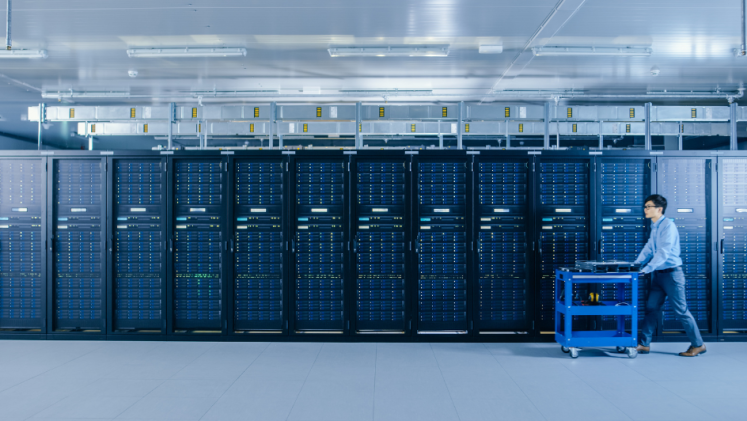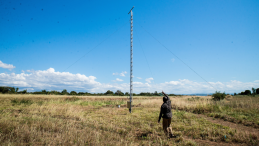While there are remarkable applications of AI in enhancing climate action, a critical question is drawing attention alike: is AI a game-changer or a tool that needs agnostic examination? Will the widespread adoption of AI technology have overall positive or negative effects on global emissions, both in the short term and long run? This was the main discussion of the townhall session “Green AI: Boom AI, Bust the Climate?” at the recent Bonn AI Climate Expert Meeting hosted by UNU-EHS.
Question of power: How green is AI?
Electricity is consumed in both the training as well as utilization of AI: especially large language models (LLM) and other key ancillaries, such as cloud services, require large amounts of data handling and computing power. The International Energy Agency (IEA) estimates that global electricity demand from data centres could double in the next two years, reaching the electricity consumption level of Japan. Additionally, data centres and their cooling infrastructures require large amounts of water, sometimes exacerbating pressure on already limited freshwater resources. These are only two among several manifestations of the negative environmental impact of AI.
At the same time, there is an untapped potential to continuously make AI greener: data centres can run on renewable electricity, chip designs are becoming increasingly energy efficient, and AI algorithms have the potential to be run smarter and faster, allowing us to make overly complex processes significantly more efficient. While this development is projected to continue, greening efforts by regulators and the industry have been outpaced by the sheer dynamic of the AI revolution. For instance, Microsoft, a company with a firm 2030 carbon neutrality pledge, reported an increase in emissions of almost 30 per cent in 2023 due to the growth of their data centres. There are significant regional variations as well; for example, Google was able to run its Northern EU-based data centres more than 90 per cent of the time on renewable energies in 2022, whereas for Asia-based centres, this number drops to less than 20 per cent. Fossil fuel-based electricity generation contributes to global climate change and can exacerbate local pollution and health hazards. These examples spotlight the significance of making AI greener and underline the need for regulatory action, including the development of green industry standards.
Can AI systematically change the speed and scale of the energy transition?
Estimating the environmental impact of AI technologies solely based on their individual resource footprint and energy use would be short-sighted. Instead, it needs to be gauged against their transformational potential for the entire energy system. The International Renewable Energy Agency (IRENA) estimates that by 2050 at least 90 per cent of the world’s electricity can and should come from renewable energy sources. The digitalization of the power sector presents significant opportunities to advance the energy transition. AI offers potentially game-changing capabilities to measure, predict and optimize complex systems in electricity generation and demand management – systems that are too intricate for current analytical tools. This acceleration in the development of sustainability solutions includes the creation of new and more sustainable materials, with the potential to leapfrog battery technologies and other power sources.
While the use case of energy transition is hopeful and might outweigh the environmental impact of the technology itself, its manifestation is far from certain. To judge the transformative potential of AI and galvanize action by policymakers, stakeholders and tech companies, one approach could be to incorporate AI-relevant variables in existing socioeconomic scenarios, both at the global level and in localized futures relevant to people and communities.
Reframe: Seeing how AI is used for or against the climate
Focusing merely on the direct emission during the training and usage of AI technology presents only a partial picture of the AI’s environmental impacts and benefits. Instead, AI needs to be viewed as a disruptive technology that will result in change. Whether this change is good or bad, depends on us. For instance, AI technology could be used to accelerate clean tech development, but it could also be used to optimize oil production, extractive industries or other emission-creating activities. It can be used to efficiently route public transport options; however, it could also result in increased individual motorized traffic. AI-aided platforms can help better explain public policies, illustrate priorities and assist decision-making in climate matters, but they can also be used to create divisive, discriminating and false information and undermine the scientific consensus on climate change.
Advancing a true green AI agenda beyond a piecemeal approach, AI overhype or greenwashing will require carefully intertwining AI and climate policies. It starts with a comprehensive assessment of the problem. It will require proactive AI regulation and public investment in digital and data infrastructures that works for everyone in the society, particularly its most vulnerable and marginalized sections who conspicuously lack access to digital means across the world. Rebound effects, both at individual and societal levels, need to be avoided.
An active climate policy approach is needed that sets economic incentives, enforces regulations and results in necessary behavioural shifts. Forging necessary social change, which is to be accelerated by technological change, requires well-capacitated decision makers and stakeholders. Finally, we also need to critically reflect on the potential as well as the usage of AI to avoid expecting it to become the ultimate tool to fix climate change. A transparent and trustworthy system that fosters customized and efficient AI-driven solutions with sustainability and equity as its main objectives needs careful planning and needs to consider all of society.
This article features key insights from the session “Green AI: Boom AI, Bust the Climate?” of the Bonn AI Climate Expert Meeting.





